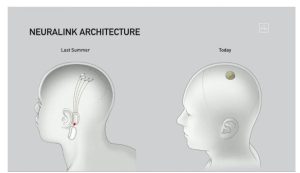Prof Dr. Hassan Mahmood Mousa Abo Almaali
Pharmacy
What are Neuralink chips and what are their applications?
Neuralink, led by Elon Musk, Neuralink chips have the potential to unlock the brain’s full potential. This could lead to applications in various fields, such as restoring lost functions in paralyzed individuals or enhancing human cognition.
(1).
What are the differences between Neuralink chips and electroencephalogram (EEG)
Though both Neuralink chips and EEG interact with the brain, they function in fundamentally different ways.
The goal:
Neuralink chips: The goal of Neuralink chips is to interface directly with neurons in the brain, enabling a real-time information exchange.
Electroencephalogram: Measures the electrical activity of the brain from outside the skull using electrodes placed on the scalp. It provides a broader picture of brain activity but does not offer the same level of accuracy and detail as Neuralink chips.
Body penetration range:
Neuralink chips: Body-penetrating, requiring surgical implantation in the brain. This makes it more serious and complex than an EEG.
Electroencephalogram: Non-invasive and does not require any surgical intervention. This makes it more user-friendly, but also limits its capabilities.(2)
Getting information:
Neuralink chips: This technique lets scientists zoom in on individual brain cells, capturing their activity in great detail.
Electroencephalogram: Only measures the combined electrical activity of large groups of neurons, making it difficult to identify specific areas or functions in the brain.
Applications:
Neuralink chips: This innovative Neuralink chips could become game-changers in medicine, offering solutions for regaining lost senses and movement, treating neurological conditions, and even improving how we think.
Electroencephalogram: Often used in research and hospitals, this method helps diagnose epilepsy, study sleep issues, and monitor brain activity while patients are under anesthesia.(3)
Neuralink chip components
A tiny brain implant called the Neuralink chip is inserted through a quick and easy surgery. Researchers are creating ultra-thin, flexible electrodes like threads, outnumbering thousands, to interface with neurons. These electrodes capture the brain’s electrical activity and convert it into digital signals that can be interpreted by external electronic devices.
The chip itself is a wonderful example of precision manufacturing. In addition, it is encased in a tightly sealed shell that is biocompatible with the human body, and it also includes an application-specific integrated circuit (ASIC) responsible for signal processing, power management, and wireless communication.
Components of the mind-machine system (Neuralink system)
The Neuralink chip is just part of a complex system designed to facilitate seamless interaction between the human brain and the computer. The system includes the following:
A- Surgical robot: A specially designed robot ensures precision in a size that makes the chip implantation process safe and accurate.
B- Link: It includes a small device behind the ear consisting of a battery, communication chips, and other necessary components. It transfers data wirelessly between the chip and external devices.
C- Decoder: Advanced algorithms analyze the neural data captured by the chip, decode brain signals and translate them into executable commands.(4)
What is the mechanism of action of the Neuralink chip?
The Neuralink chip process can be divided into three stages:
1- Acquisition of the neural signal:
Electrical sensors pick up electrical activity generated by nearby neurons as they fire electrical signals.
The housing facilitates efficient signal transmission and reduces background noise.
2- On-chip processing:
OCPU filters out irrelevant noise and performs basic compression of the signal. This pre-processing reduces the volume of data transmitted wirelessly, reducing power consumption and heat generation.
3- Wireless data transmission and decoding:
The processed neural data is sent wirelessly to an external decoder. The decoder interprets the neural signals, translating them into commands or meaningful information. Depending on the application, the decoded information could be used to control external devices, restore lost sensory or motor functions, or even provide insights into brain activity for scientific research purposes.
What are the potential applications for Neuralink chips?
The applications of Neuralink’s planned chips are as wide as human imagination. Including but not limited to the following:
A – Medical applications: Neuralink chips are expected to provide restoration of lost sensory and motor functions in individuals who suffer from paralysis, blindness, or other neurological conditions. Brain-computer interfaces hold the potential to revolutionize how we interact with the world, allowing thought-controlled prosthetics and the restoration of sight.
B- Enhancing human cognition: The developers hope these chips will improve memory, learning, and decision-making by providing users with continuous information and strengthening their mental abilities.
C – Direct communication between brains: Soon, technology could allow people to transmit information straight from brain to brain, making communication effortless.
D – Beyond just control, Neuralink chips open doors for entirely new ways to interact with technology. Imagine using your thoughts to paint, sculpt, or compose music in ways never before possible. (4)
Ethical considerations:
The potential benefits of BCIs are vast, but the ethical considerations are complex. Moving forward requires careful navigation to ensure this technology serves humanity, not the other way around.
The way forward: The future of Neuralink chips
Neuralink: A revolution in brain science, but with a cautious approach. Trials are underway to ensure the technology is safe and ethically sound.
Neuralink’s breakthroughs hold the promise of not only healing lost abilities but also pushing human potential to unseen heights. This confluence of neuroscience and technology signifies a revolutionary leap in scientific understanding and human achievement.
References:
1. https://Neuralink.com/.
2. Ben Guarino, Elon Musk’s Neuralink Has Implanted Its First Chip in a Human Brain. What’s Next? The wealthiest person on Earth has taken the next step toward a commercial brain interface, Scientific American, 2024.
3. Shaima, Mujiba , Nabi, Norun , Rana, Md , Islam, Md , Ahmed, Estak , Tusher, Mazharul , Mukti, Mousumi & Saad-Ul-Mosaher, Quazi. (2024). Elon Musk’s Neuralink Brain Chip: A Review on ‘Brain-Reading’ Device. Journal of Computer Science and Technology Studies. 6. 200-203. 10.32996/jcsts.2024.6.1.22.
4. Musk E; Neuralink. An Integrated Brain-Machine Interface Platform With Thousands of Channels. J Med Internet Res. 2019 Oct 31;21(10):e16194.






























































